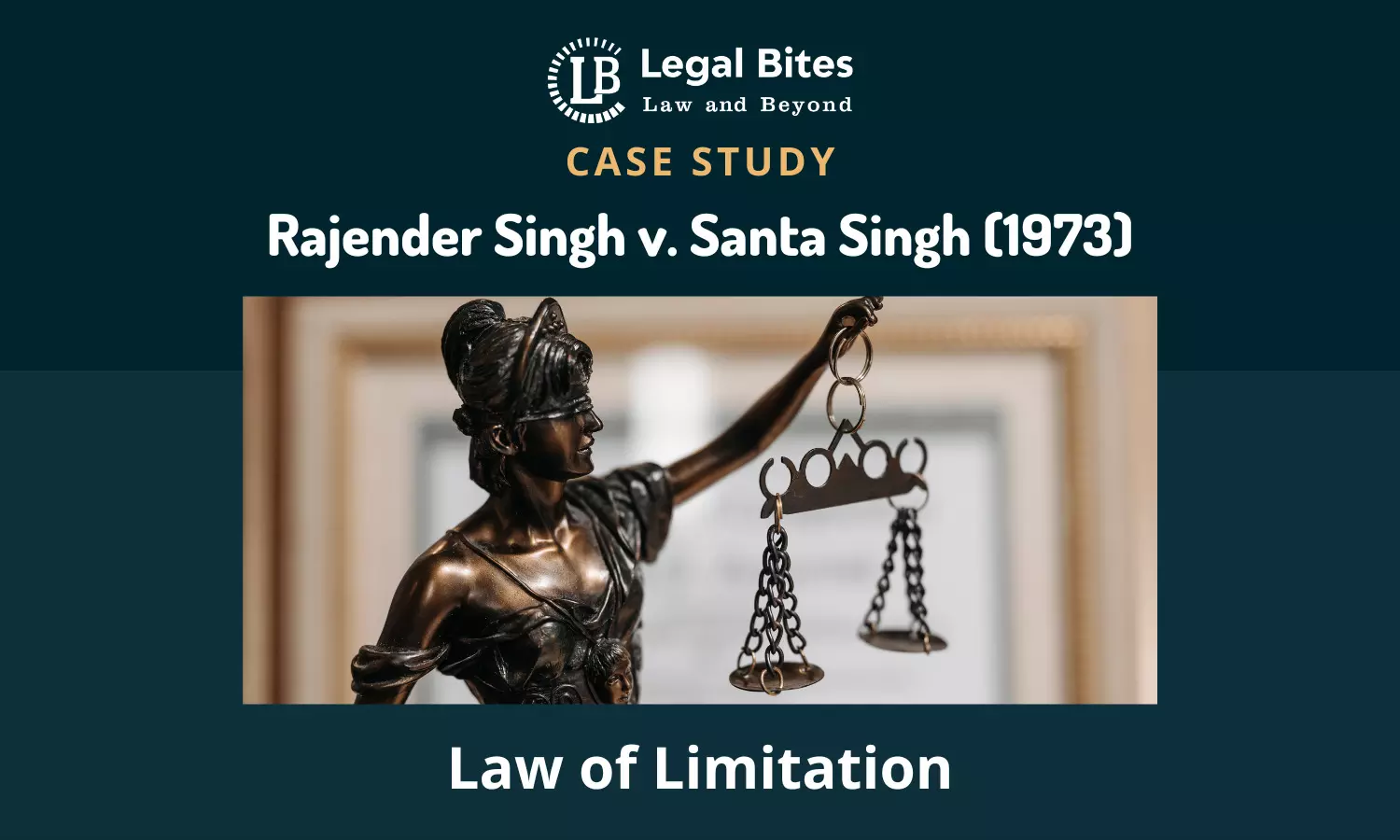Case Study: Rajender Singh v. Santa Singh (1973) | Law of Limitation
The 'Case Study: Rajender Singh v. Santa Singh (1973)' stands as a crucial legal precedent in property law, particularly addressing the law of limitation.

The 'Case Study: Rajender Singh v. Santa Singh (1973)' stands as a crucial legal precedent in property law, particularly addressing the law of limitation. The court in this case engaged in a detailed deliberation on the matter of lis pendens and its implications on the limitation period within the context of property law.
Case Title: Rajender Singh v. Santa Singh
Court: Supreme Court of India
Citations: AIR 1973 SC 2537
Judges: Justice K.K. Mathew and Justice M.H. Beg
Date of Judgment: August 16th, 1973
Facts
- In 1959, the appellants commenced a legal action to claim 331 Kanals and 11 Marlas of land from the respondents.
- The appellants, being the sons of Smt. Premi and heirs to Sham Singh, the original landowner, received a gift of the disputed plots in 1935 from Smt Malan, the widow of Sham Singh.
- Smt. Khemi, the younger sister of Smt. Premi, also made a gift to the appellants before she died in 1944.
- The appellants acquired possession of the entire gifted land, but legal uncertainties arose regarding daughters’ rights and a widow’s power to donate under the customary laws in Punjab.
- In 1940, the respondents, the 8th-degree collaterals of Sham Singh, initiated a suit for the possession of the disputed land.
- The suit was halted for almost 5 years from 1941 to 1946 under the Indian Soldiers (Litigation) Act, as the appellants were entitled to its benefits.
- A dispute over mutation was also resolved in revenue courts in favour of the appellants in 1946.
- The respondents’ 1940 suit for rights and possession concluded on November 21, 1958, with a Division Bench of the Punjab High Court who ruled for the appellants.
Issue
- Does the lis pendens doctrine halt the running limitation period during the suit pendency filed in 1940 by the respondents and finally decided in 1958?
Laws Applied
- Section 52 of Transfer of Property Act, 1882 which provides for property transfer during the pendency of a suit.
- Section 28 of the Limitation Act, of 1908 mentions the extinguishment of a property right.
- Section 14 of the Limitation Act, 1908 provides for time exclusion of bona fide proceedings in a court without jurisdiction.
- Section 3 of the Limitation Act, 1908 which talks about dismissal of suits commenced after the period of limitation.
Arguments
- In the appeal, the appellants have alleged that the respondents had taken unlawful and aggressive control of the land in dispute after the 1958 High Court’s decision and have refused to deliver the possession to them.
- The respondents claimed to have possession in 1944, after Smt. Khemi’s death, so the appellants’ suit was disqualified by limitation.
- It was also contended that Article 142 of the Limitation Act, 1908 (hereinafter as “1908 Act”) does not apply to the instant matter.
Judgment
The apex court noted that the first appellate court treated Section 52 of the Transfer of Property Act (hereinafter as “TPA”) as a provision for eliminating litigation time in calculating the limitation period. It was the Division Bench which referred the question of the applicability of the lis pendens doctrine in such cases to a Full Bench of the Punjab High Court. The Full Bench observed that the respondents' adverse possession started during the earlier suit's pendency and, once initiated, could not pause solely because the respondents' possession suit was eventually dismissed by the High Court in 1958.
Regarding the application of Article 142 of the 1908 Act, the court noted the judgment of the Allahabad High Court in Bindhyachal Chand v. Ram Gharib Chand, 1934 ALJ 973 wherein it was observed that the applicability of this provision becomes a question of proof the title of the property itself and without such proof, the appellants’ suit would fail. Further, the apex court observed that the lis pendens doctrine would not cause the extinction of title as it is said to be an extinction during the pendency of the suit. So, it does not matter whether Article 142 or 144 of the 1908 Act is applicable keeping Section 28 of the Act in view. The court accepted the High Court’s view that the possession by the defendants was “open, adverse, hostile, continuous, and exclusive” for over 12 years.
Regarding the main issue which was considered to be of some importance by the court, and as mentioned above, the doctrine of lis pendens was deliberated upon to some extent. The object of this doctrine was said to bring the involved parties and others attempting to gain rights in the immovable property under the authority and control of the court, preventing the objectives of ongoing legal proceedings concerning the specific immovable property from being hindered.
In light of continuous possession, the Court noted that continued unlawful possession transforms into a legally enforceable right only after the stipulated limitation period elapses. This happens only due to the lack of action and not due to the action of the injured party who can approach any appropriate court to regain possession. The relief against the wrong can be affirmed only within the prescribed time. The court also observed the objective of the law of limitation as the law
“to prevent disturbance or deprivation of what may have been acquired in equity and justice by long enjoyment or what may have been lost by a party’s own inaction, negligence, or laches.”
Section 14 of the 1908 Act was also observed as the only provision in the Act which provided for excluding the time spent in another litigation, but it was not applicable in the instant case. The same was held for the applicability of Section 3.
Without any provision allowing the plaintiffs to extend the time and thereby fit their lawsuit into the 12-year limitation period, it is not feasible to approve an argument that would let the appellants escape the compulsory rules outlined in Section 3 along with Section 28, Articles 142, and 144 of the 1908 Act. Courts cannot create or alter legislation contained in a statute or introduce exemptions when the statutory law prohibits such actions.
All in all, the court affirmed the judgment and decree of the Punjab High Court and the said appeal was dismissed.

